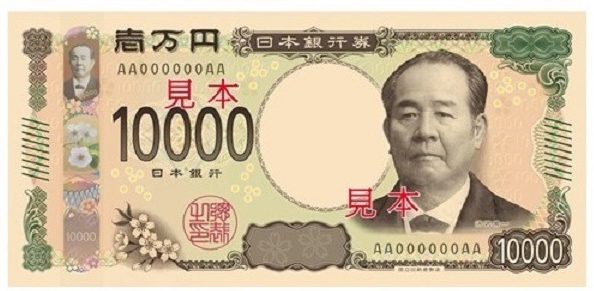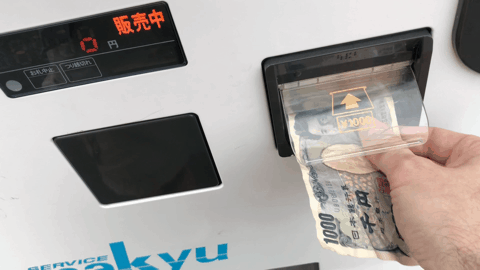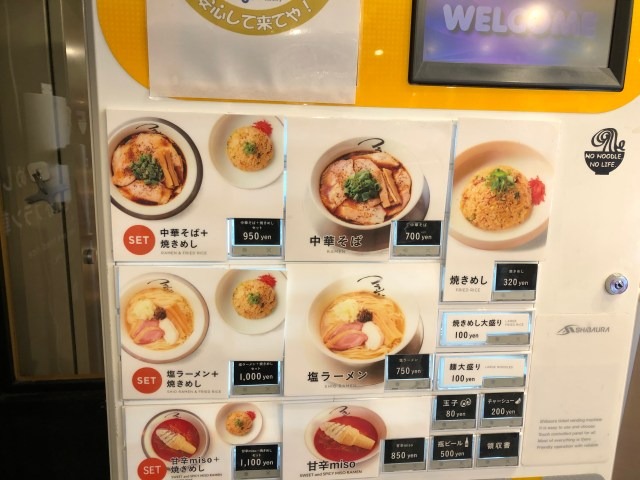
Times are tougher than undercooked noodles.
Ramen is easily one of the most enjoyable dishes in Japan, but for the many restaurants that serve it, it can be a stress-filled nightmare of existential threats. The newest such threats are coming in the form of industrialist Eiichi Shibusawa and educator Umeko Tsuda.
Before you go for the shotguns and crucifixes thinking these turn-of-the-20th-century figures have returned in zombie and/or vampire form to wreak havoc, it’s because they are two of the faces that will grace the newest series of Japanese banknotes. These bills are entering circulation this year with revamped designs.
▼ I still wouldn’t recommend letting Shibusawa bite you…

It’s well-known that Japan is the land of vending machines, which means that a change in the design of bills will also require an overhaul of each and every machine to update its bill scanner. The creation and installation of all these scanners can be extremely costly, so announcements of new bills are often met with consternation from machine operators.
▼ Wiping the bill on your T-shirt won’t get these new bills to work if the machine isn’t set up right.

While roadside vending machines are iconic, people outside the country might be surprised to see how prevalently they’re used in restaurants as well. Oftentimes, customers are greeted by a ticket machine at the front entrance where they insert money, punch in their order, and take their tickets to the staff.
▼ The ticket machine for Franken in Osaka, where you can get an ice cream cone in your ramen.

These are often used by independent restaurants since they can reduce labor costs but are also vulnerable to the costly updates. Of course, these kinds of upgrades come with the territory and are to be expected, but the timing of this particular change could prove devastating for a lot of restaurants, ramen restaurants in particular.
The main reason is that the ramen restaurant business is extremely competitive; one only needs to check a Google map of restaurants in their area to see just how competitive it is. It is said that under normal circumstances, about 80 percent of ramen restaurants go out of business in the first three years.
▼ Here are the ramen restaurants in a roughly 1.5-kilometer swath of Shinjuku through probably not all of the places there.
In addition to the debilitating effects of COVID-19 on restaurants, we’re now experiencing skyrocketing food prices which are said to have more than doubled the cost of making a bowl of ramen. Despite the rising cost of ingredients, ramen restaurants are under pressure to keep prices the same due to the aforementioned competitiveness.
To have to pay upwards of 1 million yen (US$6,500) to upgrade their ticket machines while dealing with all the other struggles will likely knock out a large number of restaurants in one fell swoop. According to one restaurant manager, it would take six months of selling 100 bowls a day to cover that cost. Some local governments like Katsushika, Tokyo have begun offering subsidies to cover part of the costs, but restaurant operators would prefer 100 percent coverage since this currency change was unilaterally the government’s decision.
There’s a pretty much zero percent chance of these new bills not coming, and doing nothing while waiting for government subsidies to come would be a really bad idea. So, in all likelihood, there will be a game of chicken between restaurants’ pricing, with many falling by the wayside either from raising prices and losing customers or keeping prices low and losing money.
The best thing we can do as lovers of ramen is to go to our favorite places as much as possible to help them weather this perfect storm of economic woes.
Source: TV Asahi, Hachima Kiko
Featured image: ©SoraNews24
● Want to hear about SoraNews24’s latest articles as soon as they’re published? Follow us on Facebook and Twitter!

 Ramen vending machine in Tokyo satisfies noodle and gyoza cravings at any time of day or night
Ramen vending machine in Tokyo satisfies noodle and gyoza cravings at any time of day or night Halloween vandals trash Tokyo ramen restaurant’s meal ticket machine, prompting ultimatum【Video】
Halloween vandals trash Tokyo ramen restaurant’s meal ticket machine, prompting ultimatum【Video】 We found a popular Japanese ramen chain in South Korea!…or so we thought
We found a popular Japanese ramen chain in South Korea!…or so we thought Tokyo’s new frozen ramen vending machines are brain-breakingly amazing【Taste test】
Tokyo’s new frozen ramen vending machines are brain-breakingly amazing【Taste test】 Poisonous blowfish ramen restaurant in Tokyo is death-defyingly delicious【Taste test】
Poisonous blowfish ramen restaurant in Tokyo is death-defyingly delicious【Taste test】 Japan’s new difficult-to-drink-from beer glass protects your liver, but it’s a brutal experience
Japan’s new difficult-to-drink-from beer glass protects your liver, but it’s a brutal experience How to order snacks on a Shinkansen bullet train in Japan
How to order snacks on a Shinkansen bullet train in Japan New samurai glasses are Japan’s latest weird must-have souvenir
New samurai glasses are Japan’s latest weird must-have souvenir New Pokémon ice cream, dessert drinks, and cool merch coming to Baskin-Robbins Japan【Pics】
New Pokémon ice cream, dessert drinks, and cool merch coming to Baskin-Robbins Japan【Pics】 Doraemon found buried at sea as scene from 1993 anime becomes real life【Photos】
Doraemon found buried at sea as scene from 1993 anime becomes real life【Photos】 Burger King Japan suddenly adds Dr. Pepper and Dr. Pepper floats to its menu nationwide
Burger King Japan suddenly adds Dr. Pepper and Dr. Pepper floats to its menu nationwide Starbucks Japan welcomes alpacas for cute summer drinkware line【Photos】
Starbucks Japan welcomes alpacas for cute summer drinkware line【Photos】 High-fashion Totoro cuddle purse is like an elegant stroll in the forest【Photos】
High-fashion Totoro cuddle purse is like an elegant stroll in the forest【Photos】 Studio Ghibli hair accessories keep your style tidy with help from Kiki, Moro, Calcifer, and more
Studio Ghibli hair accessories keep your style tidy with help from Kiki, Moro, Calcifer, and more What if Sailor Moon characters were lingerie models? They’d look stunning like this 【Photos】
What if Sailor Moon characters were lingerie models? They’d look stunning like this 【Photos】 Nintendo history you can feel – Super NES, N64, and GameCube controllers become capsule toys
Nintendo history you can feel – Super NES, N64, and GameCube controllers become capsule toys Hello, cosmetics! Clinique teams up with Hello Kitty this summer for first-time collaboration
Hello, cosmetics! Clinique teams up with Hello Kitty this summer for first-time collaboration Demon Slayer: Kimetsu no Yaiba gets new roller coaster attractions and food at Universal Studios Japan
Demon Slayer: Kimetsu no Yaiba gets new roller coaster attractions and food at Universal Studios Japan “The most Delicious Cup Noodle in history” – Japan’s French Cup Noodle wins our heart【Taste test】
“The most Delicious Cup Noodle in history” – Japan’s French Cup Noodle wins our heart【Taste test】 Starbucks releases a cute Frappuccino and Unicorn Cake…but not in Japan
Starbucks releases a cute Frappuccino and Unicorn Cake…but not in Japan Kyoto Tower mascot termination reveals dark side behind cute Japanese characters
Kyoto Tower mascot termination reveals dark side behind cute Japanese characters McDonald’s Japan’s Soft Twist Tower: A phantom ice cream only sold at select branches
McDonald’s Japan’s Soft Twist Tower: A phantom ice cream only sold at select branches Yabai Ramen: What makes this Japanese ramen so dangerous?
Yabai Ramen: What makes this Japanese ramen so dangerous? Finally! Nintendo Japan expands Switch 8-bit controller sales to everybody, Online member or not
Finally! Nintendo Japan expands Switch 8-bit controller sales to everybody, Online member or not Japanese government wants to build luxury resorts in all national parks for foreign tourists
Japanese government wants to build luxury resorts in all national parks for foreign tourists To combat declining birth rate, Japan to begin offering “Breeding Visas” to foreigners
To combat declining birth rate, Japan to begin offering “Breeding Visas” to foreigners 10 things you should buy at 7-Eleven in Japan
10 things you should buy at 7-Eleven in Japan Studio Ghibli releases anime heroine cosplay dresses that are super comfy to wear
Studio Ghibli releases anime heroine cosplay dresses that are super comfy to wear Woman charged for driving suitcase without a license in Osaka
Woman charged for driving suitcase without a license in Osaka Studio Ghibli unveils My Neighbour Totoro miniature house model
Studio Ghibli unveils My Neighbour Totoro miniature house model Kyoto experiencing problems with foreign tourists not paying for bus fares, but not on purpose
Kyoto experiencing problems with foreign tourists not paying for bus fares, but not on purpose Fighting mild hunger with a Japanese soda that turns into jelly in the stomach【Taste test】
Fighting mild hunger with a Japanese soda that turns into jelly in the stomach【Taste test】 Studio Ghibli’s Howl’s Moving Castle tapestry unveiled in Japan for first time
Studio Ghibli’s Howl’s Moving Castle tapestry unveiled in Japan for first time McDonald’s new Happy Meals offer up cute and practical Sanrio lifestyle goods
McDonald’s new Happy Meals offer up cute and practical Sanrio lifestyle goods Sales of Japan’s most convenient train ticket/shopping payment cards suspended indefinitely
Sales of Japan’s most convenient train ticket/shopping payment cards suspended indefinitely Sold-out Studio Ghibli desktop humidifiers are back so Totoro can help you through the dry season
Sold-out Studio Ghibli desktop humidifiers are back so Totoro can help you through the dry season Japanese government to make first change to romanization spelling rules since the 1950s
Japanese government to make first change to romanization spelling rules since the 1950s Foreigner’s request for help in Tokyo makes us sad for the state of society
Foreigner’s request for help in Tokyo makes us sad for the state of society Ghibli founders Toshio Suzuki and Hayao Miyazaki contribute to Japanese whisky Totoro label design
Ghibli founders Toshio Suzuki and Hayao Miyazaki contribute to Japanese whisky Totoro label design Tokyo’s most famous Starbucks is closed
Tokyo’s most famous Starbucks is closed Princesses, fruits, and blacksmiths: Study reveals the 30 most unusual family names in Japan
Princesses, fruits, and blacksmiths: Study reveals the 30 most unusual family names in Japan Old gas stations in Japan are being converted into ramen restaurants
Old gas stations in Japan are being converted into ramen restaurants This Tokyo ramen restaurant is the first to ever receive a Michelin dining guide star
This Tokyo ramen restaurant is the first to ever receive a Michelin dining guide star This hidden restaurant has amazing views of Tokyo Tower and nothing on the menu is over 10 bucks
This hidden restaurant has amazing views of Tokyo Tower and nothing on the menu is over 10 bucks What?!? Turns out kids eat for free at one of Japan’s best ramen chains, and hardly anyone knew
What?!? Turns out kids eat for free at one of Japan’s best ramen chains, and hardly anyone knew Halal ramen comes to Tokyo with Asakusa restaurant, and it’s so good anyone will enjoy it
Halal ramen comes to Tokyo with Asakusa restaurant, and it’s so good anyone will enjoy it Tokyo gets its first subway station ramen vending machine
Tokyo gets its first subway station ramen vending machine $100 ramen in Tokyo: Overpriced or totally worth it?
$100 ramen in Tokyo: Overpriced or totally worth it? Chopstick anxiety: Painfully shy Japanese diners struggle with communal restaurant containers
Chopstick anxiety: Painfully shy Japanese diners struggle with communal restaurant containers The Bank of Japan is really jazzed up about the new 10,000 yen bill
The Bank of Japan is really jazzed up about the new 10,000 yen bill All-frozen ramen restaurant appears in Tokyo, shows us we don’t really need the restaurant
All-frozen ramen restaurant appears in Tokyo, shows us we don’t really need the restaurant Japanese restaurant says its wonder ramen provides all the vegetables your body needs in one bowl
Japanese restaurant says its wonder ramen provides all the vegetables your body needs in one bowl Yoshinoya beef ramen? Gyudon king’s sister chain opens first Tokyo branch【Taste test】
Yoshinoya beef ramen? Gyudon king’s sister chain opens first Tokyo branch【Taste test】 Why did this stand-and-eat soba noodle shop in Tokyo open in the middle of the pandemic?
Why did this stand-and-eat soba noodle shop in Tokyo open in the middle of the pandemic? Tokyo’s all-female sushi chef restaurant has closed down, is being dismantled
Tokyo’s all-female sushi chef restaurant has closed down, is being dismantled How to make your own ramen food sample with real ramen, in just 1.5 hours and -22.6 degrees C
How to make your own ramen food sample with real ramen, in just 1.5 hours and -22.6 degrees C
Leave a Reply